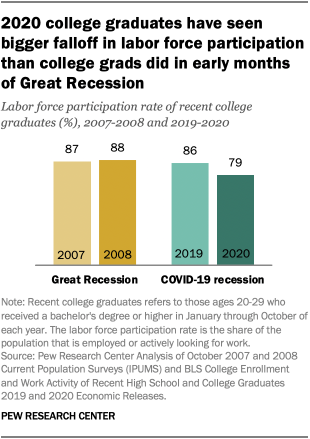
From their virtual commencements, the class of 2020 graduates looked out into a very different economic future than their predecessors the year before – one upended by a recession caused by a pandemic that has been particularly hard on young workers. The challenges of a pandemic economy are evident in the labor market outcomes of 2020 college graduates, who have experienced a downturn in employment and labor force participation, according to a new Pew Research Center analysis of data from January to October collected by the Bureau of Labor Statistics.
In October 2020, 69% of adults ages 20 to 29 who had graduated from college with a bachelor’s degree or higher during the previous spring were employed, lower than the share of 2019 graduates who were employed in October of that year (78%). The labor force participation rate for recent college graduates – or the share of people employed or actively looking for a job – also dropped from 86% to 79% during this one-year period. As has been widely documented, the broader labor market took a significant hit during the pandemic. Among all Americans ages 16 and older, the employment rate declined from 61% in October 2019 to 58% in October 2020, and the labor force participation rate declined from 63% to 62%.
This report looks at how the COVID-19 recession affected the college and high school graduating classes in 2020 to determine the impact it had on employment and labor force participation. For this analysis, we used data from the Bureau of Labor Statistics published as Economic Releases. Specifically, we used the 2007, 2008, 2019 and 2020 releases titled “College Enrollment and Work Activity of High School and College Graduates.” These tables show data from the Current Population Survey October Supplement, which gathers data on school and college enrollment.
While the pandemic did impact CPS data collection through lowered response rates, interviews had resumed by September 2020. For 2007 and 2008, data on college graduates was not included in the BLS releases, and our estimates for those years are obtained through the Integrated Public Use Microdata Series (IPUMS-CPS) provided by the University of Minnesota. The CPS, conducted by the U.S. Census Bureau for the Bureau of Labor Statistics, is the nation’s premier labor force survey and is the basis for the monthly national unemployment rate.
While it is too early to compare the long-term impacts of the COVID-19 recession and the Great Recession on recent college graduates, there is evidence that the outcomes for these young adults have differed in the months following their graduation. The labor force participation rates for the classes of 2007 and 2008 were relatively unchanged, whereas the class of 2020 saw a marked decline compared with the class of 2019.
Class of 2020 high school graduates – young adults ages 16 to 24 who graduated from high school in the previous spring – faced their own challenges as they made decisions about entering the labor market or enrolling in college, among other options. Overall, college enrollment rates are largely unchanged for the class of 2020 compared with the class of 2019. However, an earlier analysis looking at the share of all 18- to 24-year-olds enrolled in college showed that there was a slight decline in enrollment among certain demographic groups, including Black and Asian young adults.
Among high school graduates who were not enrolled in college in the fall after graduation, the employment rate was similar in 2019 and 2020. However, there was a notable drop among women in this group: 65% were employed in 2019 vs. 54% in 2020 (there was no change among men in this group).





